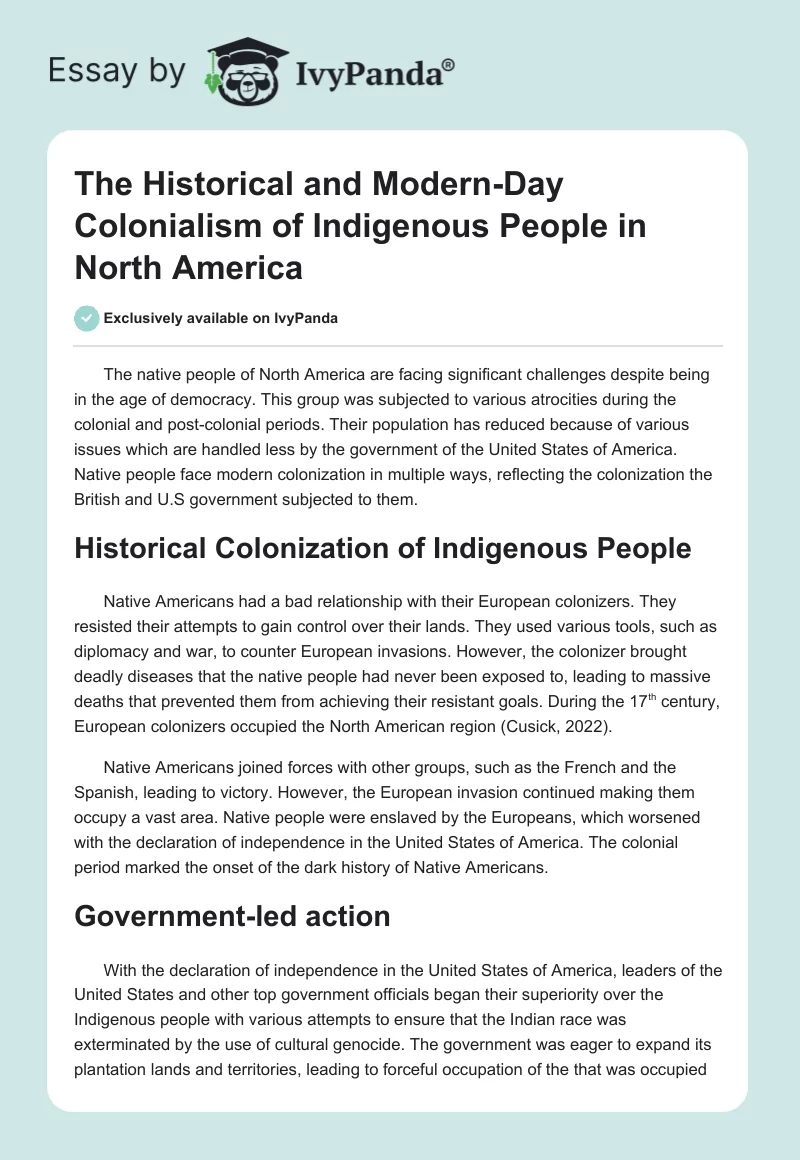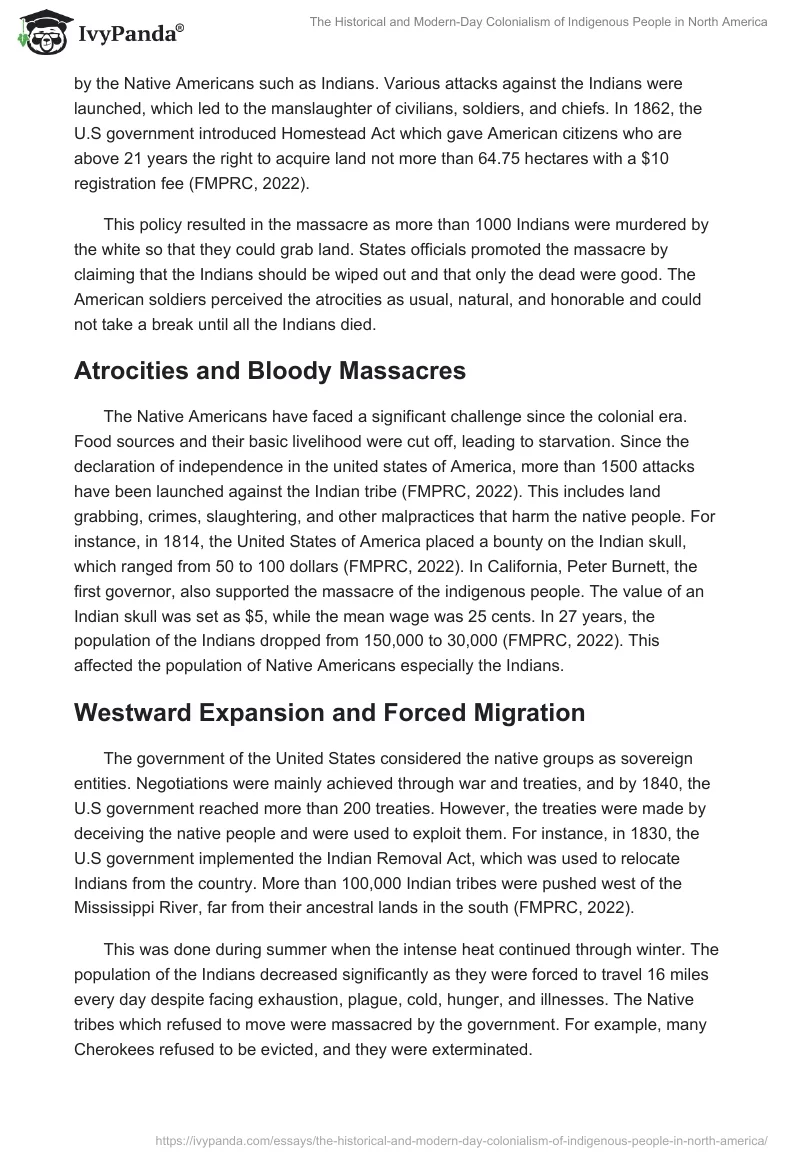The native people of North America are facing significant challenges despite being in the age of democracy. This group was subjected to various atrocities during the colonial and post-colonial periods. Their population has reduced because of various issues which are handled less by the government of the United States of America. Native people face modern colonization in multiple ways, reflecting the colonization the British and U.S government subjected to them.
Historical Colonization of Indigenous People
Native Americans had a bad relationship with their European colonizers. They resisted their attempts to gain control over their lands. They used various tools, such as diplomacy and war, to counter European invasions. However, the colonizer brought deadly diseases that the native people had never been exposed to, leading to massive deaths that prevented them from achieving their resistant goals. During the 17th century, European colonizers occupied the North American region (Cusick, 2022).
Native Americans joined forces with other groups, such as the French and the Spanish, leading to victory. However, the European invasion continued making them occupy a vast area. Native people were enslaved by the Europeans, which worsened with the declaration of independence in the United States of America. The colonial period marked the onset of the dark history of Native Americans.
Government-led action
With the declaration of independence in the United States of America, leaders of the United States and other top government officials began their superiority over the Indigenous people with various attempts to ensure that the Indian race was exterminated by the use of cultural genocide. The government was eager to expand its plantation lands and territories, leading to forceful occupation of the that was occupied by the Native Americans such as Indians. Various attacks against the Indians were launched, which led to the manslaughter of civilians, soldiers, and chiefs. In 1862, the U.S government introduced Homestead Act which gave American citizens who are above 21 years the right to acquire land not more than 64.75 hectares with a $10 registration fee (FMPRC, 2022).
This policy resulted in the massacre as more than 1000 Indians were murdered by the white so that they could grab land. States officials promoted the massacre by claiming that the Indians should be wiped out and that only the dead were good. The American soldiers perceived the atrocities as usual, natural, and honorable and could not take a break until all the Indians died.
Atrocities and Bloody Massacres
The Native Americans have faced a significant challenge since the colonial era. Food sources and their basic livelihood were cut off, leading to starvation. Since the declaration of independence in the united states of America, more than 1500 attacks have been launched against the Indian tribe (FMPRC, 2022). This includes land grabbing, crimes, slaughtering, and other malpractices that harm the native people. For instance, in 1814, the United States of America placed a bounty on the Indian skull, which ranged from 50 to 100 dollars (FMPRC, 2022). In California, Peter Burnett, the first governor, also supported the massacre of the indigenous people. The value of an Indian skull was set as $5, while the mean wage was 25 cents. In 27 years, the population of the Indians dropped from 150,000 to 30,000 (FMPRC, 2022). This affected the population of Native Americans especially the Indians.
Westward Expansion and Forced Migration
The government of the United States considered the native groups as sovereign entities. Negotiations were mainly achieved through war and treaties, and by 1840, the U.S government reached more than 200 treaties. However, the treaties were made by deceiving the native people and were used to exploit them. For instance, in 1830, the U.S government implemented the Indian Removal Act, which was used to relocate Indians from the country. More than 100,000 Indian tribes were pushed west of the Mississippi River, far from their ancestral lands in the south (FMPRC, 2022).
This was done during summer when the intense heat continued through winter. The population of the Indians decreased significantly as they were forced to travel 16 miles every day despite facing exhaustion, plague, cold, hunger, and illnesses. The Native tribes which refused to move were massacred by the government. For example, many Cherokees refused to be evicted, and they were exterminated.
Forced Assimilation and Cultural Extinction
Native Americans have faced numerous atrocities, such as forced assimilation in the hands of the United States government. The United States adopted forced assimilation, where the Native Americans were subjected to this policy to end their affiliation and tribal identity. This ensured that they were transformed into Americans with citizenship and consciousness. This was done through a series of steps, such as tribal deprivation. The American Indians used to govern themselves, which promoted their physical and spiritual strength (Smith & LaDuke, 2015). The U.S government abolished the tribal system pushing them to join the white society, which has a different tradition. This made them unable to find jobs that fit them, leading to their deprivation. For instance, the Cherokee tribes had material life similar to whites. However, with self-governance deprivation, they gradually declined and became the poorest among the Native people.
Land reservation was used to destroy and disintegrate Native American groups. The 1887 Dawes Act was used to end land ownership among the native people. This disintegrated the native communities. The government abolished and banned rituals such as the “Sun Dance” to prevent indigenous cultural unities. The lands that belonged to the native people were transferred to the whites through auctions. American citizenship was forced on native people, making them drop their tribal identity.
Modern-Day Colonization of Native Americans
Violence Against native women
Modern American society is still colonizing the native people through various ways which deprive them of their rights. Native women significantly experience violence which has reached significant levels. Indian women and Alaska natives are greatly affected by violence, including sexual abuse. They continue to suffer at higher rates than other groups in the United States of America. Most native American women are usually murdered or disappear, but the federal government has not provided a possible solution to the problem as this continues to increase at an alarming rate (Indian Law, 2022). Furthermore, the rate at which native women are murdered is higher than the national average. Despite these sufferings being recorded, the government of the United States has not opted for a long-term solution to the problem.
Land Rights
The indigenous people in the United States have been subjected to multiple injustices and marginalization of legal systems. The economic disparity between them and the whites also promotes the injustices towards them. Native people are still facing land challenges, making it hard to improve their well-being. The current land policy in the U.S favors the whites over the native, making them lead a difficult life despite owning lands during the pre-colonial period (Indian Law, 2022). A significant population of Indian communities in America cannot get hold of their ancestral land. They cannot prove land ownership because of the policies implemented after the United States gained independence. Land grabbers and other invaders threaten the Native American community despite having a government.
Unfavorable Law
The U.S government has laws that negatively affect the native people. The regulations affect the Indian and Alaska natives making it impossible for them to grow their social and economic life (Indian Law, 2022). For instance, most of the native people were poor because of land reforms which made it difficult for them to own land. Additionally, they are discriminated against for participating in activities that may help them improve their societal position. This has led to systemic racism where the state and its authorities.
Health Disparities
Native Americans still face significant health challenges which affect their population in North America. The government has provided fewer healthcare facilities that cater to their needs making them have a high risk of HIV/AIDS and other chronic diseases. For example, the Indian Health Service (IHS) was a government project to help native people, but it was underfunded, making it unable to cater to community needs (Martinchek & Carther, 2021). This makes it useless as it cannot help the Native Americans solve health problems. Additionally, mental health services are inadequate among the indigenous people increasing suicide rates.
Conclusion
Native American history repeats itself as they are still facing modern colonization. They were among the people who obstructed the European from gaining ground in North America, but after independence, they faced enormous problems. The government of the United States of America promoted their extinction through various methods such as massacre, which was conducted by civilians and soldiers. They were forced out of their ancestral land, and those retaliated were killed. The U.S government used various ways to forcefully assimilate them into the white culture, which promoted their downfall. Despite civilization, Native Americans are still facing modern colonization through violence against women, land rights which makes it difficult for them to own land, unfavorable laws, and health disparities. These factors promote Native Americans to be colonized in the current world.
References
Cusick, J. (2022). Impact of colonization on Indigenous Peoples’ culture. opentextbc. Web.
FMPRC. (2022). The American Genocide of the Indians—Historical Facts and Real Evidence. Web.
Indian Law. (2022). Issues. Web.
Martinchek, K., & Carther, A. (2021). Native communities face sustained challenges to building financial resilience. Urban Institute. Web.
Smith, A., & LaDuke, W. (2015). Conquest: Sexual violence and American indian genocide. Duke University Press.


